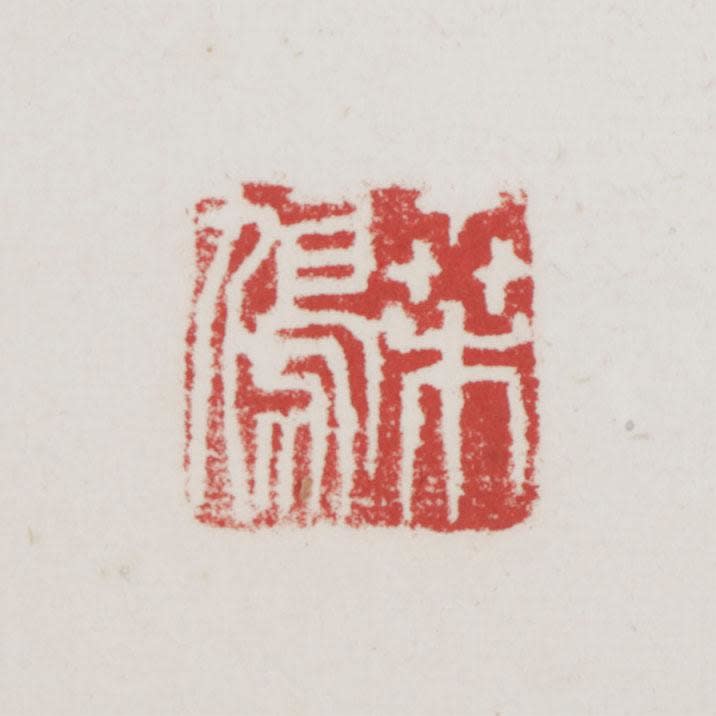Ueda Sōkyū (1899–1968)
Work
Ink on paper, framed
Seal: Sokyu
69 x 131 cm
71 x 132.5 cm (overall)
Seal: Sokyu
69 x 131 cm
71 x 132.5 cm (overall)
Further images
Ueda Sokyu was an important catalyst of the pre- and postwar era calligraphy scenes in Japan. His submission to the seventh Nitten Exhibition of 1951, Ai (Love), had caused the committee of jurors, among them eminent artists such as Matsubayashi Keigetsu, headaches for its unconventional formal choices. Would it not have been for the clearly felt resonance with the international movement of abstract expressionism, they might have rejected Sokyu straight away. Yet it was Sokyu himself who ultimately drew the line with his involvement in the Nitten institution. In 1955, he left the organization for good, setting an example for the younger generation who preferred international recognition over involvement in the academism of conventional calligraphy circles in Japan. Sokyu set a shining example especially for his students Inoue Yuichi and Morita Shiryu, who later founded the avant-garde group Bokujin-kai and aggressively pursued the project of raising Japanese calligraphy to global recognition.
A certain disregard for norms of traditional calligraphy is immediately noticeable in the present work. Sokyu has his character extend beyond the picture frame, resulting in striking crops at the upper and lower margins. Seemingly random splashes indicate the moments when the artist lifted his brush before moving on to the next stroke. The wet-in-wet effects of the large dot-like areas remind the puddled ink techniques often used in early modern painting. As Sokyu pushes his writing towards abstraction, he reveals a distinctive sense of balance and composition, captivating the viewer with the beauty of the movements of the brush.
The present work is included in archival film footage from the Bokujin-kai group made to introduce its members and affiliated artists. The movie may be dated to 1962–63, hence the work was either created specifically for it and dates to around the same time or was made slightly earlier. In addition to the present work, Sokyu is in the movie also seen executing a variation of it, yet we currently do not know if this variation still exists or if the artists completed any further works featuring the same character. In the absence of documentary materials, it remains difficult to determine which specific character Sokyu used or if he had a character in mind at all. The work Ai, mentioned above, illustrates that Sokyu often did not adhere to the expected shapes or stroke orders. That given, it appears plausible to think of his calligraphy not so much as of “characters” but rather “signs.”
Ueda Sokyu (calligrapher; 1899–1968)
Calligrapher born in Hyogo Prefecture, Sokyu studied calligraphy with Ibara Ungai and Hidai Tenrai. In 1933, he co-founded Shodo Geijutsu-sha (Art of Calligraphy Association) and became the chief editor of their journal Shodo Geijutsu. With his work spanning the pre- and postwar eras, Sokyu was an important mentor for Inoue Yuichi and Morita Shiryu of Bokujin-kai and is regarded as a leader of postwar avant-garde calligraphy in Japan.
A certain disregard for norms of traditional calligraphy is immediately noticeable in the present work. Sokyu has his character extend beyond the picture frame, resulting in striking crops at the upper and lower margins. Seemingly random splashes indicate the moments when the artist lifted his brush before moving on to the next stroke. The wet-in-wet effects of the large dot-like areas remind the puddled ink techniques often used in early modern painting. As Sokyu pushes his writing towards abstraction, he reveals a distinctive sense of balance and composition, captivating the viewer with the beauty of the movements of the brush.
The present work is included in archival film footage from the Bokujin-kai group made to introduce its members and affiliated artists. The movie may be dated to 1962–63, hence the work was either created specifically for it and dates to around the same time or was made slightly earlier. In addition to the present work, Sokyu is in the movie also seen executing a variation of it, yet we currently do not know if this variation still exists or if the artists completed any further works featuring the same character. In the absence of documentary materials, it remains difficult to determine which specific character Sokyu used or if he had a character in mind at all. The work Ai, mentioned above, illustrates that Sokyu often did not adhere to the expected shapes or stroke orders. That given, it appears plausible to think of his calligraphy not so much as of “characters” but rather “signs.”
Ueda Sokyu (calligrapher; 1899–1968)
Calligrapher born in Hyogo Prefecture, Sokyu studied calligraphy with Ibara Ungai and Hidai Tenrai. In 1933, he co-founded Shodo Geijutsu-sha (Art of Calligraphy Association) and became the chief editor of their journal Shodo Geijutsu. With his work spanning the pre- and postwar eras, Sokyu was an important mentor for Inoue Yuichi and Morita Shiryu of Bokujin-kai and is regarded as a leader of postwar avant-garde calligraphy in Japan.





